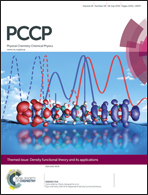A linear diffusion model for ion current across blocking grain boundaries in oxygen-ion and proton conductors
Abstract
We demonstrate the applicability of the linear diffusion model recently proposed for the current–voltage, Igb–Ugb, characteristics of blocking grain boundaries in solid electrolytes to various oxygen-ion and proton conductors: the model precisely reproduces the Igb–Ugb characteristics of La-, Sm-, Gd-, and Y-doped ceria as well as Y-doped barium zirconate to provide accurate explanations to the “power law” behavior of the Igb–Ugb relationship, i.e. Igb ∝ Ugbn, experimentally observed. The model also predicts that the grain-boundary potential, Ψgb, in doped ceria weakly depends on temperature, if the trapped charge remains constant, and that the value of Ψgb can be determined from the value of the power n. Furthermore, the model provides a plausible explanation for the increase in the Ψgb with temperature observed for the proton conductor in which the concentration of the charge carrier decreases with temperature. Hence, it is evident that the linear diffusion model is robust and applicable to grain boundaries in a large variety of practically important solid electrolytes.


 Please wait while we load your content...
Please wait while we load your content...